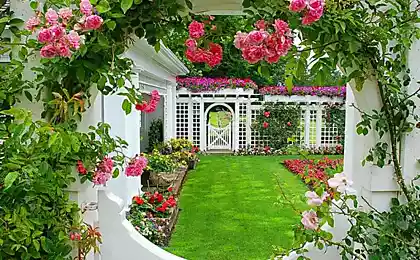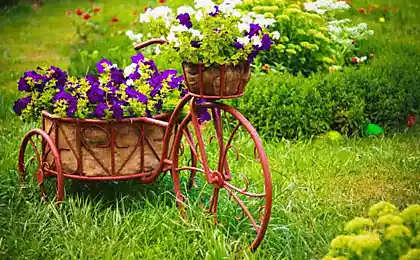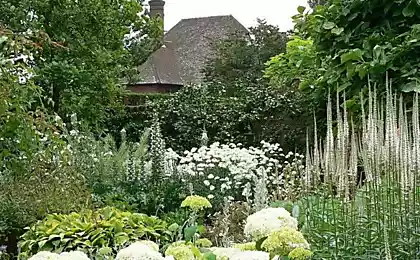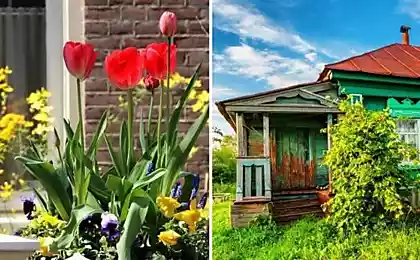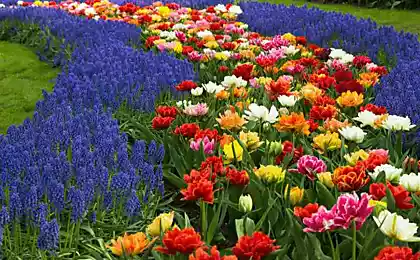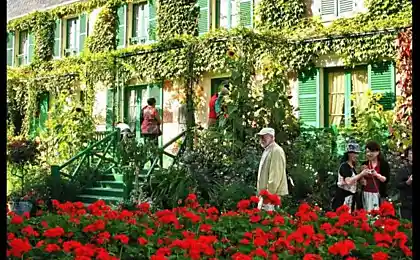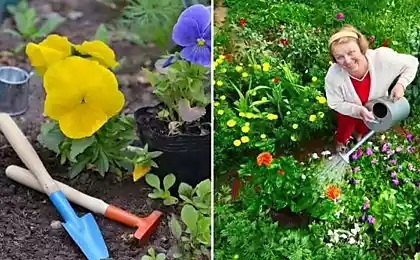487
July: work in the garden, vegetable garden, flower garden
July can be considered a continuation of last month as all the major works of the cottagers during this period correspond to the same concerns: all the same watering and fertilizing of plants, loosening the soil and so on.
The main concerns Jul are watering and fertilizing plants. To do this, use only the supernatant water, which has had time to warm up in the sun. Water your planting the roots or in the early morning or late afternoon. Do not forget to podrujit the soil in the beds.
In mid-summer our garden never looks as fine and pleases the eye with its blooming. All planting is rapidly gaining height, grow stronger, and some vegetables and trees begin to produce first yields. But the work has not been canceled, and so the rest yet.

In the garden
1. If fruit trees are noticeable dry twigs and branches begin to sawing. They are very well visible on a background of green foliage, so don't wait for the autumn.
2. Take care of next year's crop now. As practice shows, not all berry bushes indulge us with abundant harvests, so forget about them is not worth it.
3. Treat Apple and pear against scab, cherry – kokkomikoza. Protect from slimy plum Sawfly and perforated spots.
4. After harvest, be sure to treat the beds with strawberries: propolice them, podrujit aisle backfill under the roots of plants fresh fertile soil. This is to ensure that the strawberries have released the young foliage, which remains for the winter and helps the plant to stay warm under the snow.
5. With an abundant number of fruits on Apple trees, pears and plums will install a special backup that will save the branches from breaking.
6. Every day inspect the bushes with raspberries. Berries rotted, remove them immediately as they Mature.
7. Harvest of black currants also clear on the basis of ripeness. Remember that ripe fruit hang very long and can quickly crumble. This does not apply to white and red currants. The berries of these shrubs are firmly hanging on branches up to 30 days.
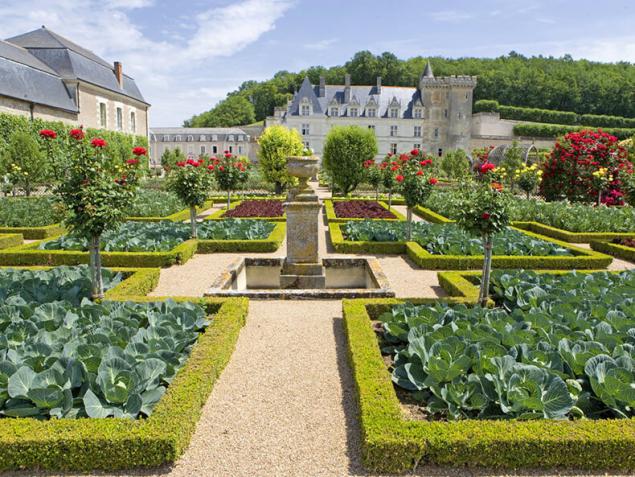
In the garden
1. B the beginning of the month spend preventive processing of tomatoes and potatoes from Phytophthora. To do this, use a copper-containing drugs type Bordeaux mixture or copper oxychloride. Remember that for potatoes they are applicable at any phase of plant growth. But for tomatoes the last processing run a maximum of 20 days before harvest.
2. The vacant beds plant growing such crops as dill, radishes, lettuce, spinach, coriander and so on, as well as turnip and radish, designed for winter storage. With sufficient irrigation, you will receive a good harvest.
3. In the first half of the winter month, dig up the garlic together with the tops, then tie the plants to "spit" and leave to dessiatina in a well ventilated area.
4. 20 days before harvest of onions, stop watering.
5. In the bushes with cauliflower a little Adamite a pair of upper leaves. This way you protect the plant from the scorching sun, to get a well-developed snow-white blossoms.
6. At the end of the month spend the seeding sorrel, rhubarb, perennial onions.
7. If the month is dry, liberally pour over the potatoes. This technique enables to achieve a rich harvest.
8. Make vershkovyi tomatoes. For that tall varieties and hybrids tear off the top. This technique will stop the further growth of the plant and will target all its power on fruitlets. Also spare bushes of tomatoes from the flowers and buds – they still will not have time to grow the fruit the normal size. Despite the fact that in July we begin to receive the long-awaited first harvest of tomatoes and cucumbers, don't forget about feeding these crops with the drugs, the main components of which are potassium and phosphorus.
9. Guide final thinning root crops. Remember, that the distance between the crops of carrot and parsley should be at least 4 cm, radish – 8-10 cm, and beet – 10-12 cm After feed vegetables with a solution of ash. July feeding roots had time to form tops, aimed at the accumulation of the cultures in sugar content. To help plants, use a potash-type calcium sulfate (1 g per 10 liters of water) or infusion of ash (1:10).
10. Shorten the loop of pumpkin bushes on the third sheet, after reaching the ovary. Cut all side shoots that have no fruit. Best of all one plant, leave no more than three ovaries. Remember frequent and abundant watering plants.
11. Don't forget about regular feeding of cucumbers and tomatoes. For these purposes, the ideal solution of ash (70 grams per liter of water), or mullein (1:10).
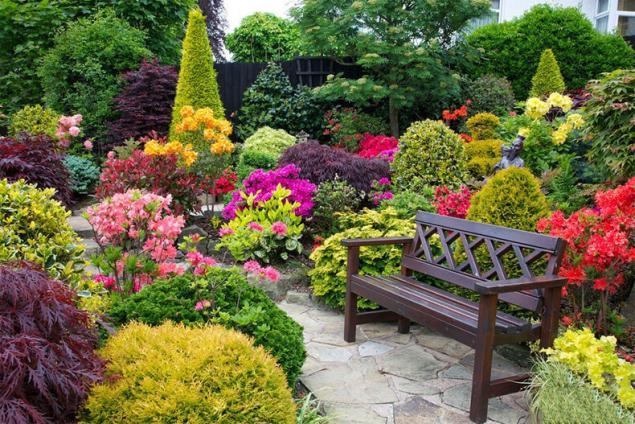
In the flower garden
1. If the flower plants you see signs of mildew, run a treatment of shrubs preventive drugs. For this purpose, the perfect tools such as "Topaz" or "Fast".
2. Do not forget about the systematic pruning of faded flowers. In any case do not allow setting of seed, as in this case, the plants weaken.
3. In order to avoid breakage of the stems of tall flowers such as gladiolas, dahlias, hollyhocks, tie them to the supports.
4. In the bushes with roses remove any thin shoots and shoots samoletnye (wildings) and to feed them with a solution of mullein at the rate of 1 part to 20 parts of water, adding 30 grams of superphosphate, 20 grams of ammonium nitrate and 8 grams of potassium chloride.
5. After flowering peonies under bushes make humus or compost and fill it with soil.
6. To protect plants from fungal diseases, spray 1 % Bordeaux liquid solution or 0.5 % solution of oxychloride of copper. For prevention need treatment once a week.
7. In the middle of the month dig bulbous culture. Bulbs clean off the ground and put it on dosushki under the canopy in a well ventilated area.
8. At the end of the month the last time fertilizing flowering annual plants, and also to thin out the seedlings of perennials.published
Technology and gardening: how to care for their suburban areas in the summer?
Free air conditioning
P. S. And remember, only by changing their consumption — together we change the world! ©
Source: sad6sotok.ru/%D0%B8%D1%8E%D0%BB%D1%8C-%D1%80%D0%B0%D0%B1%D0%BE%D1%82%D1%8B-%D1%81%D0%B0%D0%B4-%D0%BE%D0%B3%D0%BE%D1%80%D0%BE%D0%B4.html
The main concerns Jul are watering and fertilizing plants. To do this, use only the supernatant water, which has had time to warm up in the sun. Water your planting the roots or in the early morning or late afternoon. Do not forget to podrujit the soil in the beds.
In mid-summer our garden never looks as fine and pleases the eye with its blooming. All planting is rapidly gaining height, grow stronger, and some vegetables and trees begin to produce first yields. But the work has not been canceled, and so the rest yet.

In the garden
1. If fruit trees are noticeable dry twigs and branches begin to sawing. They are very well visible on a background of green foliage, so don't wait for the autumn.
2. Take care of next year's crop now. As practice shows, not all berry bushes indulge us with abundant harvests, so forget about them is not worth it.
3. Treat Apple and pear against scab, cherry – kokkomikoza. Protect from slimy plum Sawfly and perforated spots.
4. After harvest, be sure to treat the beds with strawberries: propolice them, podrujit aisle backfill under the roots of plants fresh fertile soil. This is to ensure that the strawberries have released the young foliage, which remains for the winter and helps the plant to stay warm under the snow.
5. With an abundant number of fruits on Apple trees, pears and plums will install a special backup that will save the branches from breaking.
6. Every day inspect the bushes with raspberries. Berries rotted, remove them immediately as they Mature.
7. Harvest of black currants also clear on the basis of ripeness. Remember that ripe fruit hang very long and can quickly crumble. This does not apply to white and red currants. The berries of these shrubs are firmly hanging on branches up to 30 days.

In the garden
1. B the beginning of the month spend preventive processing of tomatoes and potatoes from Phytophthora. To do this, use a copper-containing drugs type Bordeaux mixture or copper oxychloride. Remember that for potatoes they are applicable at any phase of plant growth. But for tomatoes the last processing run a maximum of 20 days before harvest.
2. The vacant beds plant growing such crops as dill, radishes, lettuce, spinach, coriander and so on, as well as turnip and radish, designed for winter storage. With sufficient irrigation, you will receive a good harvest.
3. In the first half of the winter month, dig up the garlic together with the tops, then tie the plants to "spit" and leave to dessiatina in a well ventilated area.
4. 20 days before harvest of onions, stop watering.
5. In the bushes with cauliflower a little Adamite a pair of upper leaves. This way you protect the plant from the scorching sun, to get a well-developed snow-white blossoms.
6. At the end of the month spend the seeding sorrel, rhubarb, perennial onions.
7. If the month is dry, liberally pour over the potatoes. This technique enables to achieve a rich harvest.
8. Make vershkovyi tomatoes. For that tall varieties and hybrids tear off the top. This technique will stop the further growth of the plant and will target all its power on fruitlets. Also spare bushes of tomatoes from the flowers and buds – they still will not have time to grow the fruit the normal size. Despite the fact that in July we begin to receive the long-awaited first harvest of tomatoes and cucumbers, don't forget about feeding these crops with the drugs, the main components of which are potassium and phosphorus.
9. Guide final thinning root crops. Remember, that the distance between the crops of carrot and parsley should be at least 4 cm, radish – 8-10 cm, and beet – 10-12 cm After feed vegetables with a solution of ash. July feeding roots had time to form tops, aimed at the accumulation of the cultures in sugar content. To help plants, use a potash-type calcium sulfate (1 g per 10 liters of water) or infusion of ash (1:10).
10. Shorten the loop of pumpkin bushes on the third sheet, after reaching the ovary. Cut all side shoots that have no fruit. Best of all one plant, leave no more than three ovaries. Remember frequent and abundant watering plants.
11. Don't forget about regular feeding of cucumbers and tomatoes. For these purposes, the ideal solution of ash (70 grams per liter of water), or mullein (1:10).

In the flower garden
1. If the flower plants you see signs of mildew, run a treatment of shrubs preventive drugs. For this purpose, the perfect tools such as "Topaz" or "Fast".
2. Do not forget about the systematic pruning of faded flowers. In any case do not allow setting of seed, as in this case, the plants weaken.
3. In order to avoid breakage of the stems of tall flowers such as gladiolas, dahlias, hollyhocks, tie them to the supports.
4. In the bushes with roses remove any thin shoots and shoots samoletnye (wildings) and to feed them with a solution of mullein at the rate of 1 part to 20 parts of water, adding 30 grams of superphosphate, 20 grams of ammonium nitrate and 8 grams of potassium chloride.
5. After flowering peonies under bushes make humus or compost and fill it with soil.
6. To protect plants from fungal diseases, spray 1 % Bordeaux liquid solution or 0.5 % solution of oxychloride of copper. For prevention need treatment once a week.
7. In the middle of the month dig bulbous culture. Bulbs clean off the ground and put it on dosushki under the canopy in a well ventilated area.
8. At the end of the month the last time fertilizing flowering annual plants, and also to thin out the seedlings of perennials.published
Technology and gardening: how to care for their suburban areas in the summer?
Free air conditioning
P. S. And remember, only by changing their consumption — together we change the world! ©
Source: sad6sotok.ru/%D0%B8%D1%8E%D0%BB%D1%8C-%D1%80%D0%B0%D0%B1%D0%BE%D1%82%D1%8B-%D1%81%D0%B0%D0%B4-%D0%BE%D0%B3%D0%BE%D1%80%D0%BE%D0%B4.html

